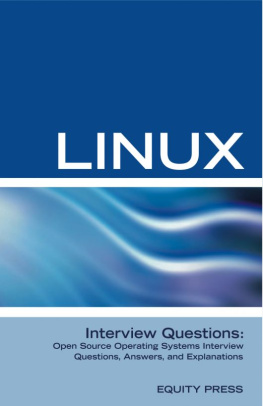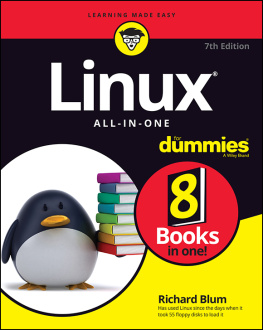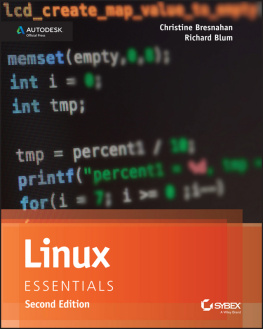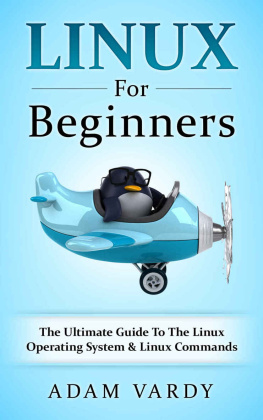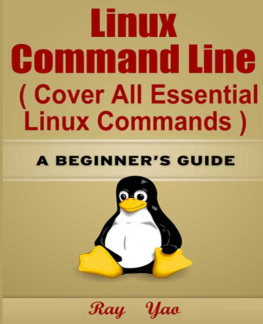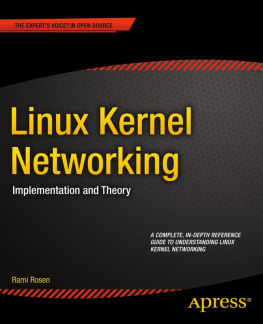LPI LinuxCertification:
Basic Level 1
By Terry Sanchez-Clark
LPI Linux Certification:Basic Level 1
ISBN:978-1-60332-230-0
SmashwordsEdition
Edited By: JamieFisher
Copyright 2008 Equity Pressand ITCOOKBOOK all rights reserved. No part of this publication maybe reproduced, stored in a retrieval system, or transmitted in anyform or by any means (electronic, mechanical, photocopying,recording or otherwise) without either the prior written permissionof the publisher or a license permitting restricted copying in theUnited States or abroad.
The scanning, uploading anddistribution of this book via the internet or via any other meanswithout the permission of the publisher is illegal and punishableby law. Please purchase only authorized electronic editions, and donot participate in or encourage piracy of copyrightedmaterials.
The programs in this bookhave been included for
instructional value only.They have been tested with
care but are not guaranteedfor any particular purpose.
The publisher does not offerany warranties or
representations nor does itaccept any liabilities with
respect to theprograms.
Trademarks: All trademarksare the property of their respective owners. Equity Press andITCOOKBOOK is not associated with any product or vendor mentionedin this book.
Please visit our websiteat www.itcookbook.com
Table ofContents
Linux is a form of the UNIXoperating system. Though originally UNIX was used mainly byengineers and scientists and thus was not well known to the generalpublic. A lot of what you take for granted on computer systemstoday began in UNIX. A notable example is the Internet, the firstmajor operating system to implement the TCP/IP protocol at theheart of the Internet was UNIX and that led to the generalacceptance of the protocol.
In the early 1990s, computerscience student Linus Torvalds decided to write his own version ofUNIX, which he called Linux. Other homegrown versions of UNIX hadbeen written, such as MINIX, but what distinguished Linux was thescale of worldwide participation involved. Torvalds innocently puta message on the Internet asking if anyone wanted to help and hegot an avalanche of responses. There are a several reasons whyLinux is the mainstream today. First, it became known as a veryreliable, stable operating system, with one result being that Linuxhas become a major platform for large corporate Web servers.Another reason is that it, and the software associated with itdeveloped elsewhere, is free. Many companies have found that it ischeaper to run Linux on their PCs, both for this reason and becauseof reduced maintenance costs.
Linux has historically beenused mainly as a server operating system, but its low cost,flexibility, and UNIX background make it suitable for a wide rangeof applications. Linux is the cornerstone of the "LAMP"server-software combination (Linux, Apache,MySQL, Perl/PHP/Python) which has achievedpopularity among developers, and which is one of the more commonplatforms for website hosting.
Due to its low cost and itshigh configurability, Linux is often used in embedded systems suchas television set-top boxes, mobile phones, and handheld devices.Linux has become a major competitor to the proprietary Symbian OSfound in many mobile phones, and it is an alternative to thedominant Windows CE and Palm OS operating systems on handhelddevices. The popular TiVo digital video recorder uses a customizedversion of Linux. Several network firewall and router standaloneproducts, including several from Linksys, use Linux internally,using its advanced firewalling and routing capabilities. Linux isincreasingly common as an operating system for supercomputers. Inthe November 2005 TOP500 list of supercomputers, the two fastestsupercomputers in the world ran Linux. Of the 500 systems, 371(74.2%) ran some version of Linux, including seven of the topten.
Clusters of Linux machinesare used in the creation of movies such as "Titanic", "Shrek" andothers. In post offices, they are the nerve centers that route mailand in large search engine, clusters are used to perform internetsearches. These are only a few of the thousands of heavy-duty jobsthat Linux is performing day-to-day across the world.
The Sony PlayStation 3 videogame console, scheduled to be released in November 2006, will runLinux by default. Sony has previously released a PS2 Linuxdo-it-yourself kit for their PlayStation 2 video game console. Gamedevelopers like Atari and id Software have released titles to theLinux desktop. Linux Game Publishing also produces games for Linux,licensing and porting them from their Windows source code. The OneLaptop per Child project, which aims to provide computing devicesto all children in developing nations, uses Linux as the devices'operating system.
It is also worth to notethat modern Linux not only runs on workstations, mid- and high-endservers, but also on "gadgets" like PDA's, mobiles, a shipload ofembedded applications and even on experimental wristwatches. Thismakes Linux the only operating system in the world covering such awide range of hardware.
Linux is an open sourceoperating system which is free as in freedom, so that the sourcecode is available for anybody to view, distribute, use, and edit.Everybody is allowed to edit the program to suit his or her ownneeds, or give it away. This is in contrast to Windows, where thesource code can be edited and reviewed only by Microsoft employeesand people who agree to sign a non-disclosure agreement. Linuxadvocates claim that their openness means that code can be reviewedby many people, who can submit bug fixes or newfeatures.
At first a computer runningMinix was necessary in order to configure and install Linux.Initial versions of Linux also required another operating system tobe present in order to boot from a hard disk, but soon there wereindependent boot loaders such as LILO. The Linux system quicklysurpassed Minix in functionality; Torvalds and other early Linuxkernel developers adapted their work for the GNU components anduser-space programs to create a complete, fully functional, andfree operating system.
Today, Torvalds continues todirect the development of the kernel, while other subsystems suchas the GNU components continue to be developed separately (Linuxkernel development is not part of the GNU Project). Other groupsand companies combine and distribute these components withadditional application software in the form of Linuxdistributions.
Linux is predominantly usedas part of a Linux distribution (commonly called a "distro"). Theseare compiled by individuals, loose-knit teams, and commercial andvolunteer organizations. They commonly include additional systemand application software, an installer system to ease initialsystem setup, and integrated management of software installationand upgrading. Distributions are created for many differentpurposes, including computer architecture support, localization toa specific region or language, real-time applications, and embeddedsystems, and many deliberately include only free software.Currently, over three hundred distributions are actively developed,with about a dozen distributions being most popular forgeneral-purpose use.
A typical general-purposedistribution includes the Linux kernel, some GNU libraries andtools, command-line shells, the graphical X Window System and anaccompanying desktop environment such as KDE or GNOME, togetherwith thousands of application software packages, from office suitesto compilers, text editors, and scientific tools
Linux is a combination of several different technologies. The LinuxKernel was started in 1991 (based on earlier kernels), while the XWindow System, which provides graphics in Linux, and the GNUproject, which is a set of command-line based tools similar toMS-DOS, were both started in 1984.
There are several goodreasons for you to use Linux:
Next page
